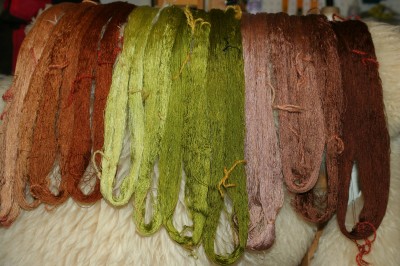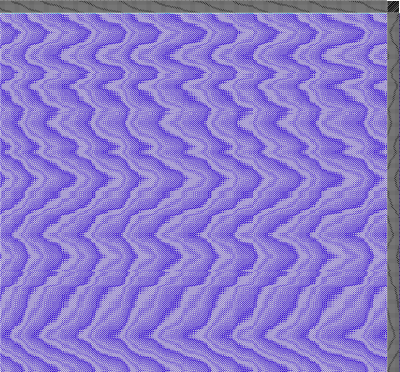The 20/2 tencel arrived yesterday evening, and I lost no time – I’ve dyed two batches of weft colors and beamed on 90% of the warp already.
Here is a photo of my weft colors:

These are dyed with Cibacron F fiber-reactive dyes, three colors at four intensities each. My original intent was to use a single weft in this piece, and just test out the different colors/intensities to see which I like best. But now that I’ve seen the weft colors (they are gorgeous, aren’t they?), another idea has popped up to explore…gradation dyeing, in color and intensity, starting with pale green at the top and finishing with dark brown at the bottom. This intrigues me, because it is a new thought – my prior attempts at gradation dyeing were all done with two “pure” colors and at the same intensity. Using a three-color mix and altering the concentration of dye simultaneously sounds really interesting! and, as we all know, interesting things should be played with, so I am seriously considering doing some gradation-dyeing tests with differing intensities of green, golden brown, and dark brown. (That’s assuming these wefts work out, of course.)
I have beamed on the warp in four sections: clear Lurex thread, metallic gold embroidery thread, clear, iridescent nylon thread, and a very fine polyester-cotton mixed yarn. Each section of these is mixed with tencel in a 1:4 ratio, with 1 strand of the metallic being carried in the same heddle as every fourth strand of tencel yarn. When burned out, the tencel will all go away, leaving only the fine threads.
I had intended to put on the threads in a 1:8 ratio, but it was so much easier to beam on with four cones and a 1:4 ratio that I decided to start there. If 1:4 turns out to be too dense, I’ll do another sample at 1:8.
I also needed to redo the draft, since I had gone from 1440 threads to 800, so here it is:

In this case I opted for a four-end network, as it created smoother curves and I didn’t feel I needed the high contrast 6 ends would give. I made it a descending 4-end network (4-3-2-1 instead of 1-2-3-4) because, if you are right-handed, it is easier to thread and sley a descending series than an ascending one. I learned that from Laura Fry (hi Laura!) and it has made my life much easier when designing and threading drafts with straight runs.
Plan for this weekend is to get a bunch of smaller items off my to-do list, and to finish warping/start weaving the devore sampler. With only 800 threads to do, and the warp almost fully beamed, I should be able to start weaving this weekend. So stay tuned for photos!

Those colors are to die for!! So complex and subtle. What were the original colors that you used?
Makes me want to head out for my dyes . . .